Nottinghamshire
NOTTINGHAM
Nottingham had a part to play in the founding of two remarkable non-conformist movements - the Society of Friends and the Salvation Army. They appeared two centuries apart, very different in character but with striking parallels. Both defied the social conventions of the day and encountered bitter hostility, even from fellow Christians; both gave a prominent place to women, and adopted characteristic dress, and both sought to minister to the poor and disadvantaged. Here the similarities end. After their initial birthpangs, the Friends became pacifist, meditative - almost mystical - and dedicated to philanthropy. They would have been uncomfortable with the brash exuberance of William Booth's Army, with their military titles and brass bands, but would have applauded their commitment to the poor.
George Fox (1624-1691) was here in 1649, at the beginning of his preaching career and still groping for the truth. He entered a church, interrupting the service and denouncing the minister. Not surprisingly, he was arrested and sentenced to a spell in prison - the first of many. A similar incident at Derby a year later led to his appearance before Justice Gervase Bennett, whom he commanded to tremble at the name of the Lord! This gave Fox's movement its familiar nickname, the Quakers, which it has borne honourably ever since.
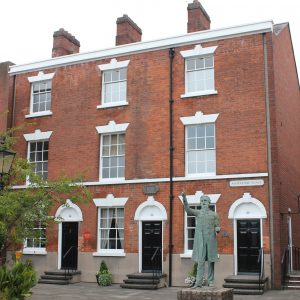
William Booth Birthplace Museum
William Booth (1829-1912) was born at 12 Notintone Place (NG2 4QG), a secluded courtyard just off Sneinton Road, not far from the city centre. Together with adjoining properties on either side, this forms the three-storey red brick William Booth Memorial Museum, which can be visted by appointment. A statue of the full-bearded General, arm raised in preaching, stands outside. Adjacent modern buildings provide an education and conference centre to promote the Army's work.
Arranged on three floors, the exhibits include some of Booth's personal possessions, photographs of his life and work and items illustrating the history of the Salvation Army over 150 years. In the entrance hall is the door of Francis Eames' pawnbrokers shop where Booth began his working life and, on the first floor, the room where Booth was born is furnished in late Georgian style.
A few days after his birth, young William was baptised at St Stephens Church on the other side of Sneinton Road, but the present building, a forbidding stone pile, dates from about ten years later. He also attended the church for two years as a young teenager.
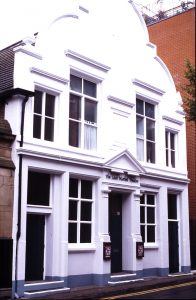
Samuel Biddulph's academy
William's father enrolled his only son at Samson Biddulph's Academy, the building which now houses the Lace Market Theatre, in Halifax Place off Pilcher Gate (NG1 1QN). Booth received a rudimentary education but, due to his father's financial problems, he had to leave and at thirteen was apprenticed to Francis Eames, a pawnbroker, whose shop stood where there is now a clump of trees opposite the Ice Stadium in Bellar Gate. His experience of the pawnshop, where women would sometimes surrender their most precious possessions to provide liquor for their menfolk, determined the course of his life. In 1842, Booth saw the rise of the Chartist Movement in Nottingham, and was attracted by the fervent oratory of its leader, Feargus O'Connor.
Influenced by the Biddulph family, Booth started to attend the Broad Street Wesleyan Chapel and it was here in 1844 that he was converted under the preaching of Isaac Marsden. From now on it was Methodism rather than Chartism that provided the focus for his zeal. The chapel has now been replaced by the modern Broadway Cinema Complex (NG1 3AL) with its mosaic tiled columns; a bronze plaque in the foyer with a relief portrait commemorates Booth's conversion. As an eager young layman, he would round up children from the poorer parts of the city and march them up Stoney Street to the chapel for Sunday services. Their unwashed presence did not meet with the approval of the church dignitaries and it was this that prompted Booth to move to London.
The work of the Salvation Army continues in Nottingham with a modern men's hostel at Sneinton House in Brook Street. This is close to where Booth preached his first sermon - a house in Kid Street. Both house and street have gone - they stood adjacent to the Byron Works factory in busy Lower Parliament Street. At the junction of King Edward Street and Beck Street are the William Booth Memorial Halls and Citadel, erected in 1915. Here, too, a tablet in the foyer celebrates Booth's conversion.
Nottingham also played host to William Carey (1761-1834), when he preached a celebrated sermon on 30th May 1792, calling on the church to "use means" to preach the gospel to the heathen, rather than rely on the passive forces of history to extend the boundaries of Christendom. His efforts led to the foundation of the Baptist Missionary Society and the beginnings of the modern missionary movement. The Friar Lane chapel where the sermon was delivered has long since disappeared.
BABWORTH
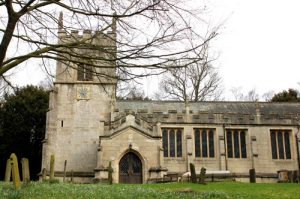
All Saints, Babworth
The remarkable story of the Pilgrim Fathers began amid the flat, dull lowlands that straddle the borders of Nottinghamshire, Yorkshire and Lincolnshire. The tale is a complex one, and it takes us from these counties to Holland, thence to Southampton and Plymouth, and finally to the hazardous coast of New England.
Babworth is a tiny village just west of Retford, but is as good a place to start as any. Details of the early life of Richard Clifton (1553-1616) are vague, but it is known that he was inducted as vicar of All Saints Church on 11th July 1586. At Scrooby, a few miles to the north, lived William Brewster (1566-1644), a man of some status and position, who was Master of the Post. Austerfield, just across the border in Yorkshire, was the home of William Bradford (1589-1657). These were three key players in a drama that would change the history of the world.
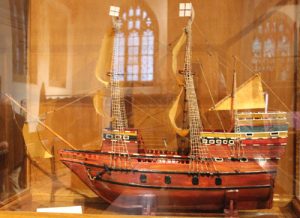
Mayflower model
All Saints Church (DN22 8EP) lies hidden behind trees up a narrow lane but its part in the Pilgrims' story has not been forgotten. A plaque in the porch records the main events and one of the church bells is dedicated to Clifton's memory. Among Clifton's congregation were Brewster and the youthful William Bradford, who at the age of twelve or thirteen would walk the twelve miles from Austerfield to church each Sunday. There are various mementoes in the church, including a wooden model of the Mayflower, built by the inmates of a local prison, when a former vicar also served as the prison chaplain. An oil painting on the north wall shows soberly dressed puritans making their way to church through a wooded landscape. Clifton's rectory was the large, white multi-gabled manor house between the road and the church, now called Haygarth House and privately owned.
Clifton was influenced by the Separatist views of Robert Browne. Early in the seventeenth century, his preaching began to attract the unwelcome attention of the church authorities. Probably for this reason, the congregation moved to Scrooby, meeting in Brewster's house from about 1606. In 1608, they moved again to Amsterdam and thence to Leyden in 1609, where they remained for about ten years before the final transatlantic adventure.
Close to Babworth is the town of Retford, where a new Pilgrims Gallery has been opened at Bassetlaw Museum in Grove Street (DN22 6LD) to coincide with the 400th anniversary of the Mayflower voyage. There are display panels describing different aspects of the venture and an interactive section with sound and visual images, including a realistic impersonation of William Brewster answering a selection of questions. Close by in Cannon Square (DN22 6PB) is The Hub, serving as a tourist information centre, art gallery and craft shop, which also has a small museum upstairs devoted to the Pilgrim Fathers. For further information on related locations see www.pilgrimsandprophets.co.uk
SCROOBY
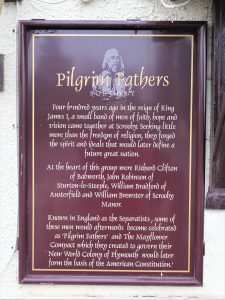
Pub sign, Scrooby
This is an unexciting name for an unexciting place, but the story it has to tell is full of drama. The grey stone church of St Wilfrid (DN10 6AR) dates from the thirteenth century, but it was extensively restored in 1864, with many of the furnishings removed, apart from some 16th century pews, known as Brewster's pews, their backs carved with a grapevine motif. A brass plaque records that William Brewster was baptised here in about 1566, but the original font went to America. Display boards tell the story of separatism and the Pilgrims Fathers, with details of Brewster's family and quotes from contemporary diaries and records.
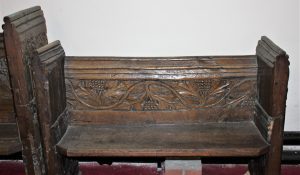
Brewster's pews
Brewster's father was Master of the Posts, an important position on this stretch of the Great North Road, and lived in the Manor House, a former palace of the Archbishops of York, where Cardinal Wolsey and Henry VIII had both spent time. Brewster himself attended Cambridge University and entered the service of Sir William Davison, a diplomat in the reign of Queen Elizabeth. He later succeeded his father in both the job and the impressive residence that went with it. It was here that Richard Clifton's congregation began to meet when it moved from Babworth. Clifton was later joined by John Robinson (1575-1625), who shared his separatist views and is generally recognised as pastor of the Pilgrim Fathers.
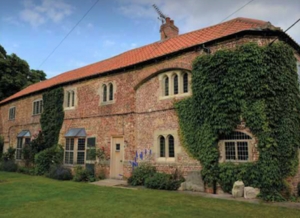
Scrooby Manor
Scrooby Manor lies down Manor Road, close to the railway line, but is privately owned and only accessible by invitation. Brewster's home would have been in this area, but the buildings have been much altered from that time. The pub on the main road is called the Pilgrim Fathers, but those worthy gentlemen might not have appreciated that kind of immortality.
STURTON-LE-STEEPLE
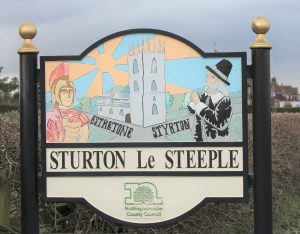
Village sign, Sturton
Sturton calls itself The Town on the Street, but is really just a village, stretching half a mile along the old Roman road. The village sign has a Roman soldier and also a Puritan, which gives a clue to its part in our story.
This is the presumed birthplace of John Robinson (1575-1625), who acted as pastor and advisor to various separatist congregations, who fled first to Holland, and some then to America as the Pilgrim Fathers. A double-fronted house in Cross Street, just opposite the turning to Freeman's Lane and now much altered, has been suggested as Robinson's former home.
Another family from Sturton played a significant part in the story of the Pilgrims. Each of the four daughters of Alexander White married separatists; Bridget married Robinson, while her elder sister Katherine married John Carver, who became the first governor of the new colony in America. The other sisters were Jane and Frances, and all four families were exiled in Leiden for a time. The Carvers joined the Mayflower voyage, but unfortunately both died within a few months of arrival.
The Church of St Peter and St Paul (DN22 9HL) has a tower with twelve pinnacles (but no steeple!) and a useful display board describing Robinson's role in the Pilgrims' story, together with a timeline of other contemporary world events. In their early life, Robinson and the White family would have been members of this congregation.
SAUNDBY
Thomas Helwys (1575-1616) is acknowledged as one of the founders of the Baptist denomination. He was a Nottinghamshire man, living at Broxtowe Hall, which no longer exists, but little is known of his early life.
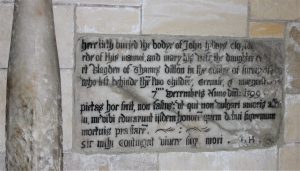
John Helwys memorial
The Church of St Martin of Tours (DN22 9ER), no longer used for worship, has one of the few memorials relating to the Helwys family. It commemorates the death of a John Helwys (possibly an uncle) in 1599. It is likely that Thomas stayed with relatives here while attending the congregation of John Smyth at Gainsborough, just across the border in Lincolnshire. Both men held separatist views, but differed from others in their view that baptism was for adult believers, not infants.
The church is approached through a farmyard where you can park, but make the staff aware of your presence to avoid being locked in! Much of the interior is occupied by bell frames removed from the tower for safety.
ASLOCKTON
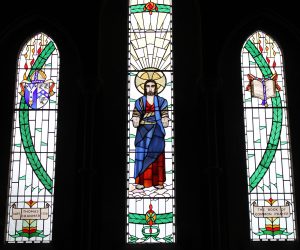
Cranmer window
This was the birthplace of Thomas Cranmer (1489-1556), and the village seems determined that no visitor should fail to be aware of it. It is mentioned on the village sign, the local pub is the Cranmer Arms, and a modern complex adjoining the church is the Thomas Cranmer Centre, available for local community events. A signboard gives an account of the archbishop's life and a guide to relevant locations.
A private residence called Cranmer House, just opposite the church, stands on the presumed site of the family's home. The footpath beside the church (inevitably called Cranmer's Walk) leads to a system of earthworks in a field, with a hillock called Cranmer's Mound. This may have been the "motte" of a motte and bailey fortress in Norman times. The depressions were probably medieval fishponds. It is said that as a boy, he used to sit here and listen to the church bells at Whatton a mile or so away.
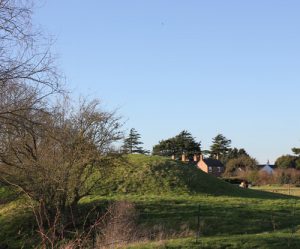
Cranmer's Mound
Cranmer left the village at fourteen and his path took him to Jesus College, Cambridge, then to Canterbury as Henry VIII's archbishop, and finally to Oxford, where he died at the stake under Henry's daughter, Mary Tudor. We tell his story in more detail on other pages.
The east window of the late nineteenth century church of St Thomas (NG13 9AN) commemorates Cranmer, mentioning just his dates and his great legacy to the Church of England - the Book of Common Prayer.
At the nearby village of Whatton-in-the Vale, the Church of St John of Beverley has a Cranmer Chapel, where a tablet commends the Archbishop's piety, learning and skill in letters, as reflected in the prayer book.
EAKRING
The village lies about half way between Nottingham and Retford. William Mompesson (1639-1709), hero of the plague village of Eyam in Derbyshire, came here as rector of St Andrew's Church (NG22 0DB) in 1670 and remained until his death nearly forty years later. He is buried within the church and there are three stained-glass windows and a brass plate to his memory in the chancel. It is said that when he arrived, the villagers thought he might still be carrying the infection and barred him from the church and parsonage. Undeterred, for a time he continued to preach in the open air on the edge of the village, as he had during the plague months at Eyam.


